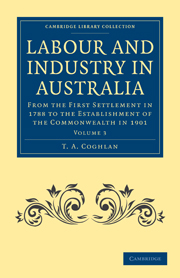 Labour and Industry in Australia
Labour and Industry in Australia Book contents
I - INTRODUCTION TO THE SIXTH PERIOD
Published online by Cambridge University Press: 07 October 2011
Summary
The sixth period covers the twenty years from 1873 to 1893, and falls naturally into two divisions, the earlier extending for about fifteen years, during which Australia enjoyed a large measure of prosperity and showed a rapid expansion of industry and commerce, and the closing years, which were a time of violent disturbance, social and economic. The two are grouped together because the prosperity of the earlier years was coupled with an orgy of speculation in land, mines, and properties of all kinds, which did much to promote discontent and unrest among the industrial classes, and led directly to the great financial crisis of 1893, which shook Australian trade and industry and even the social life of the country to their very foundations.
The development which took place during 1873—89 proceeded upon the same general lines in all the colonies, and was in a sense an attempt to make up for the lack of enterprise and time lost in the previous period. The movement was characterized at the time as “a spirited policy of public works,” and its beneficial effects were felt almost immediately in a revival of trade and enterprise. There were throughout the period important mineral discoveries, which contributed greatly to the wealth of the colonies. The discoveries of gold and other minerals, which came so opportunely in Queensland after the financial collapse of 1866, have been referred to in the introduction to the previous period.
- Type
- Chapter
- Information
- Labour and Industry in AustraliaFrom the First Settlement in 1788 to the Establishment of the Commonwealth in 1901, pp. 1231 - 1279Publisher: Cambridge University PressPrint publication year: 2011First published in: 1918
